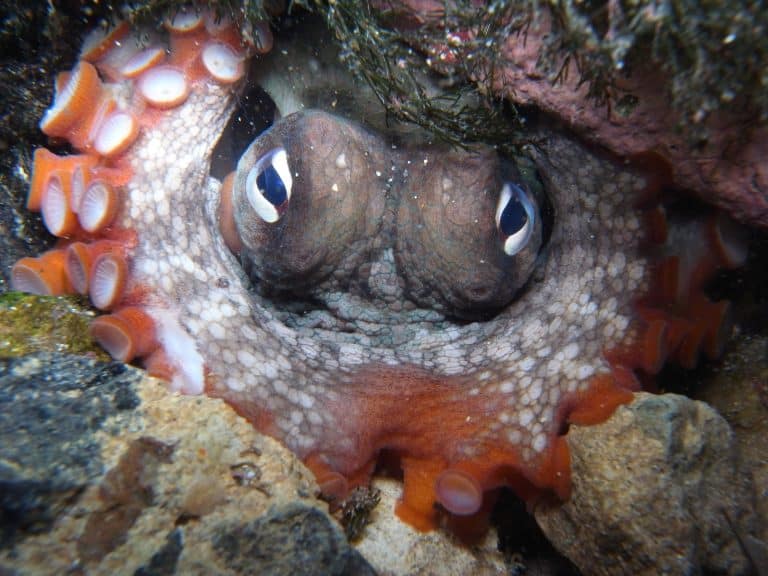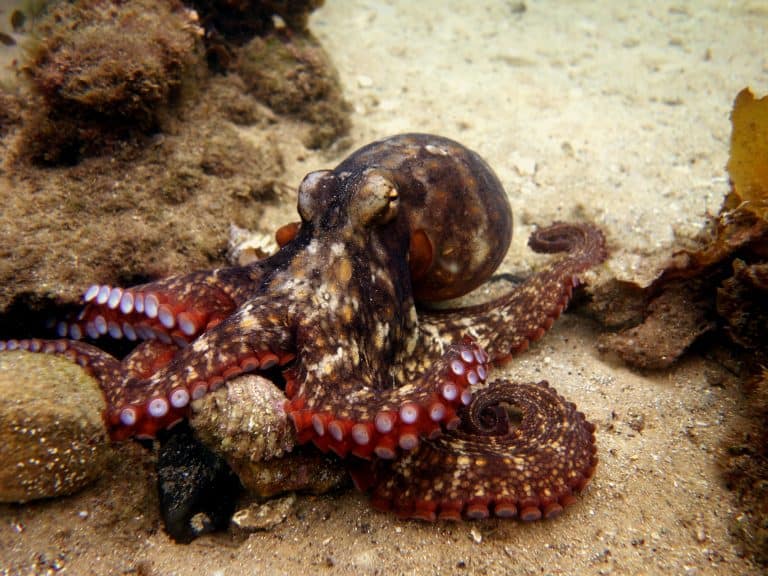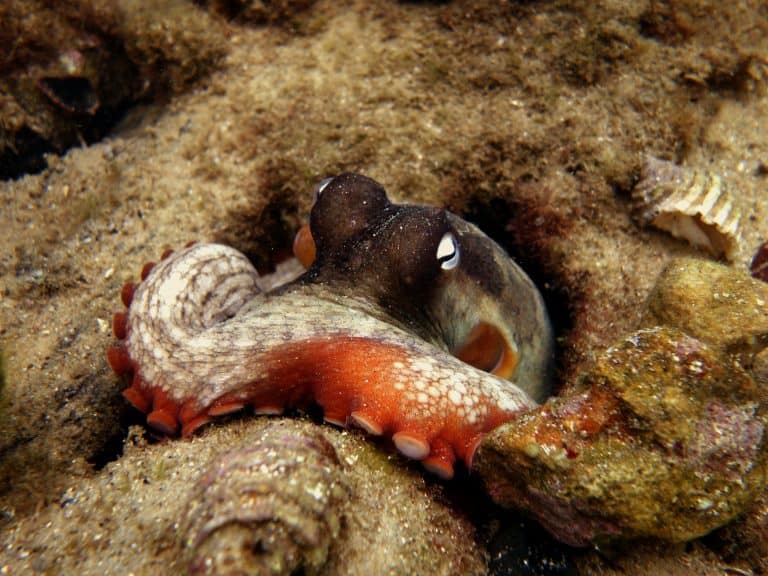Common Sydney Octopus
Octopus tetricus
The common Sydney octopus can be easily recognized by its sad-looking white eyes. They’re sometimes called the “gloomy octopus” because scientists long thought this was a solitary species, but it turns out that this octopus isn’t lonely or sad!
Sydney octopuses are actually pretty sociable, forming groups and building dens near each other. One location is so crowded that it’s known as “Octopolis”!
Size
2 ft long (60 cm)
Lifespan
11 month
Habitat
Rocky reefs
Diet
Crustaceans, gastropods, bivalves, each other!
Range
Tropical & subtropical Atlantic Ocean
Predators
Moray eels & other reef predators
superpower
Engineering
These octopuses create entire underwater cities, made of recycled materials like scallop shells!
SCIENTIFIC NAME: Octopus tetricus

SIZE OF THE COMMON SYDNEY OCTOPUS
The common Sydney octopus is a moderately large and muscular species growing up to 60 cm (2 ft) in total length with a mantle length of 14 cm (5.5 in) and weighing more than 1 kg (2.2 lbs). It’s arms are moderate to long (3 to 4.5 times the mantle length) and larger animals have 220 to 260 suckers on each normal arm. The size and life span of common Sydney octopuses is thought to vary with their environmental conditions.
COMMON SYDNEY OCTOPUS LIFESPAN
This species is thought to be very short-lived with an average life span of 11 months; however, environmental conditions can affect development, growth, maturation, and the overall life span. For example, water temperature can influence how quickly eggs mature and how fast juveniles grow.
DISTRIBUTION
The common Sydney octopus can be found along Eastern Australia from eastern Victoria to southern Queensland. It is also found along northern New Zealand, but is known as Octopus gibbsi. Another octopus species is found in Western Australia at similar latitudes and is named Octopus tetricus. However, scientists suggest this western form is a distinct but related species.

HABITAT
The species can be found on rocky reefs, especially during breeding season, and soft-sediment habitats from depths of 0 m to at least 60 m (197 ft). Their dens are formed in rock crevices or excavated under rocks on sand or mud. They have been found to inhabitat patch reefs over broken or flat reef habitats.
DIET
They spend most of the day in their dens remaining alert for predators. At night, they forage for prey on reefs and soft sediment. Their diet primarily consists of crustaceans, gastropods, and bivalves. The common Sydney octopus has been known to be cannibalistic, particularly in association with high densities and post-mating predation of the males by females.

BODY PATTERNS AND BEHAVIORS
Active animals are typically cream to mottled orange and dark brown with a pair of white spots present on the dorsal mantle. In some color patterns, they can have dark, narrow bands across their arms. This species is capable of raising their skin to have large papillae, which includes four large papillae in a diamond pattern on the dorsal mantle and one above each eye.
When resting inside the den, this species typically has a grey dorsal surface with the ventral (or underside) arms being bright orange and the eyes with a white iris- this gives them their other common name, the gloomy octopus.
Common Sydney octopuses were, for a long time, considered to be purely solitary. However, in 2012, scientists scuba diving in Jervis Bay, Australia, came across a group of common Sydney octopuses all living in a large pile of discarded shells. At this location, the octopuses forage for bivalves including scallops and bring their catch back to the site for consumption, discarding the shells at the site.
These discarded shells were then utilized by common Sydney octopuses to stabilize the walls of their burrows or dens. Sixteen octopuses were observed at the site at any one time giving this location the name Octopolis. With octopuses living in close proximity to each other comes interactions. Octopuses were observed mating and fighting, even during the daytime, and scallop shells might have become projectile weapons!
This was the first time the use of visual signals during agonistic interactions among octopuses was documented! When an approaching octopus in dark body color was matched by the reacting octopus, they would fight! If the approaching octopus was met by reacting octopus in a paler color, the paler octopus would retreat. Octopuses also “stood their ground” by standing tall with a spread web and elevated mantle.
Shortly after discovering Octopolis, scientists found a second location, dubbed Octlantis, consisting of three rock patches surrounded by mounds of shells where scientists counted 23 octopus’ dens! Next, surveillance cameras were set out for 8 days and revealed up to 15 octopuses!
The octopuses mated, fought, chased, and kicked each other out of their dens. The interactions were so intense that at one point the octopuses didn’t notice or react to a bottom-dwelling carpet shark, Wobbegong, nearby. It is likely that the limited den space may have led to these crowded conditions.
- Anderson T. (1997) Habitat selection and shelter use by Octopus tetricus. Mar. Ecol. Prog. Ser. 150: 149-155.
- Godfrey-Smith P., Lawrence M. (2012) Long-term high-density occupation of a site by Octopus tetricus and possible site modification due to foraging behavior. Mar. Freshw. Behav. Physiol. 45(4): 261-268
- Jereb, P.; Roper, C.F.E.; Norman, M.D.; Julian K Finn (eds) Cephalopods of the world. An annotated and illustrated catalogue of cephalopod species known to date. Volume 3. Octopods and Vampire Squids. FAO Species Catalogue for Fishery Purposes. No. 4, Vol. 3. Rome, FAO. 2014. 370 p
- Scheel D., Godfrey-Smith P., Lawrence M (2016) Signal use by octopuses in agonistic interactions. Current Biology 26:377-382.
- Scheel D., Chancellor S., Martin H., Lawrence M., Linquist S., Godfrey-Smith P. (2017) A second site occupied by Octopus tetricus at high densities, with notes on their ecology and behavior. Marine and Freshwater Behavior and Physiology 50:285-291. https://doi.org/10.1080/10236244.2017.1369851
- Allcock, L., Headlam, J. & Allen, G. 2018. Octopus tetricus. The IUCN Red List of Threatened Species 2018: e.T163280A993510. https://dx.doi.org/10.2305/IUCN.UK.2018-2.RLTS.T163280A993510.en
- Hickok, Kimberly, 2018, “Australia’s ‘Gloomy Octopus’ Finds Warmth, Food, Happiness in Tasmania”, Live Science – livescience.com/62921-gloomy-octopus-moves-south.html
- Body Size, Growth and Life Span: Implications for the Polewards Range Shift of Octopus tetricus in South Eastern Australia, Jorge E. Ramos, Gretta T. Pecl, Natalie A. Moltschaniwskyj, Jan M. Strugnell, Rafael I. Leo’n, Jayson M. Semmens, PLoS ONE 9(8): e103480. doi:10.1371/journal.pone.0103480
- “Did they mean to do that? Accident and intent in an octopuses’ garden”, The Conversation / By Martin Hing and Peter Godfrey-Smith, ABC News – abc.net.au/news/2017-11-14/octopus-garden-octlantis-accident-and-intent-the-conversation/9149288
- “Biologists Have Discovered an Underwater Octopus City And They’re Calling It Octlantis”, by David Nield, 2018, ScienceAlert – sciencealert.com/marine-biologists-discover-an-underwater-octopus-city-octlantis-jervis-bay-australia
- Population genetic signatures of a climate change driven marine range extension, Jorge E. Ramos, Gretta T. Pecl, Natalie A. Moltschaniwskyj, Jayson M. Semmens, Carla A. Souza & Jan M. Strugnell, Scientific Reports volume 8, Article number: 9558 (2018)
- Habitat selection and shelter use by Octopus tetricus, Tara J. Anderson, Marine Ecology Progress Series, Volume 150: 131-148, 1997
Our mission is simple: We work to inspire wonder of the ocean by educating the world about octopuses.
We work with scientists, educators, and artists to make a global impact.
OctoNation® is a 501(c)(3) Nonprofit Organization